With a primary mirror measuring 6.6m across made from 18 gold-coated segments, the James Webb Space Telescope (JWST) is a beautiful instrument in its own right.
But stunning as this technological marvel might be, it’s nothing compared to the remarkable data it has unearthed over the last year.
JWST launched on 25 December 2021, reaching its operational orbit at the second Lagrange point, 1.5 million kilometres from Earth, a month later.
After a few more months calibrating its instruments, it was finally ready to turn its gaze on the Universe.
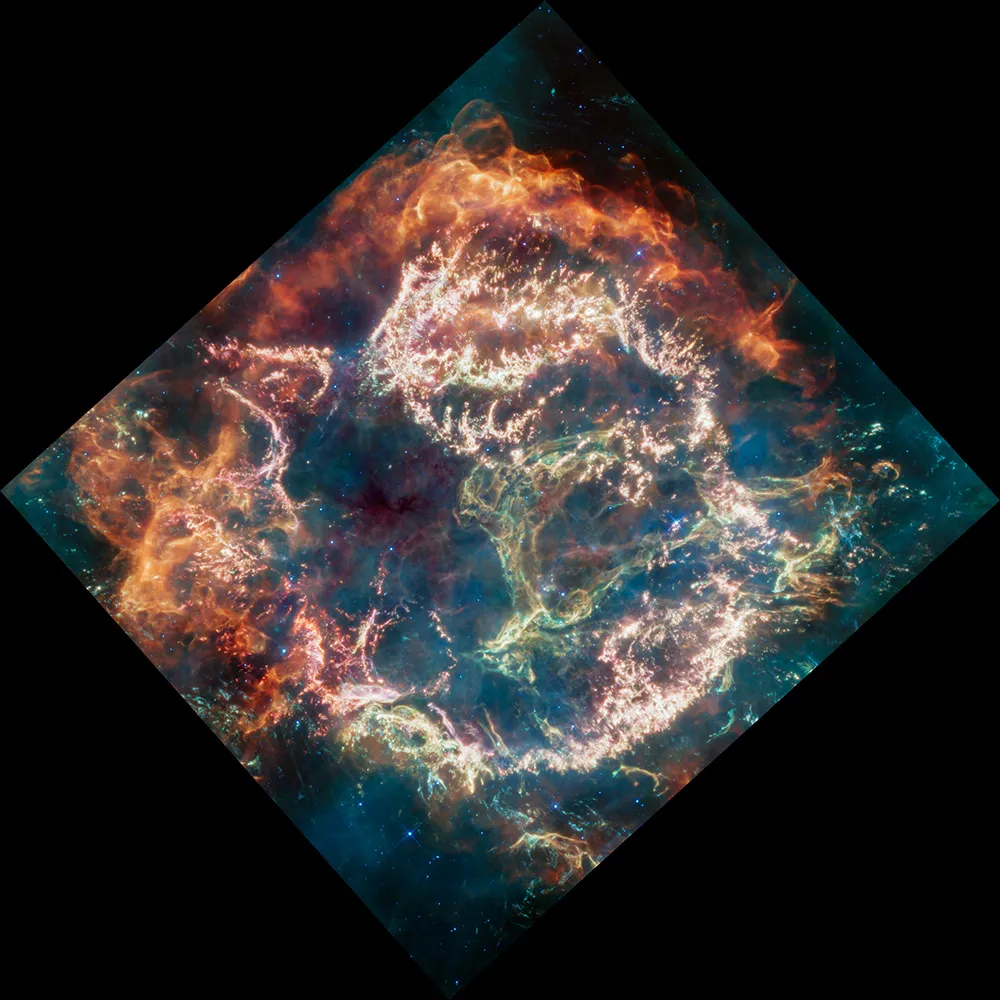
The Webb Telescope has been tasked with investigating four main science goals:
- The early Universe and the first galaxies
- The growth and evolution of galaxies over time
- The lifecycle of stars
- The study of other worlds
The new telescope is uniquely suited to investigating these goals as it observes infrared wavelengths.
This light can pass through clouds of dust and gas, and reveal warm objects that do not shine in visible wavelengths, meaning it can peer into corners of the Universe previously hidden from view.
JWST began returning its first remarkable scientific findings in July 2022.
Here we look back at some of the milestones it achieved during its first year.
The first galaxies in the Universe
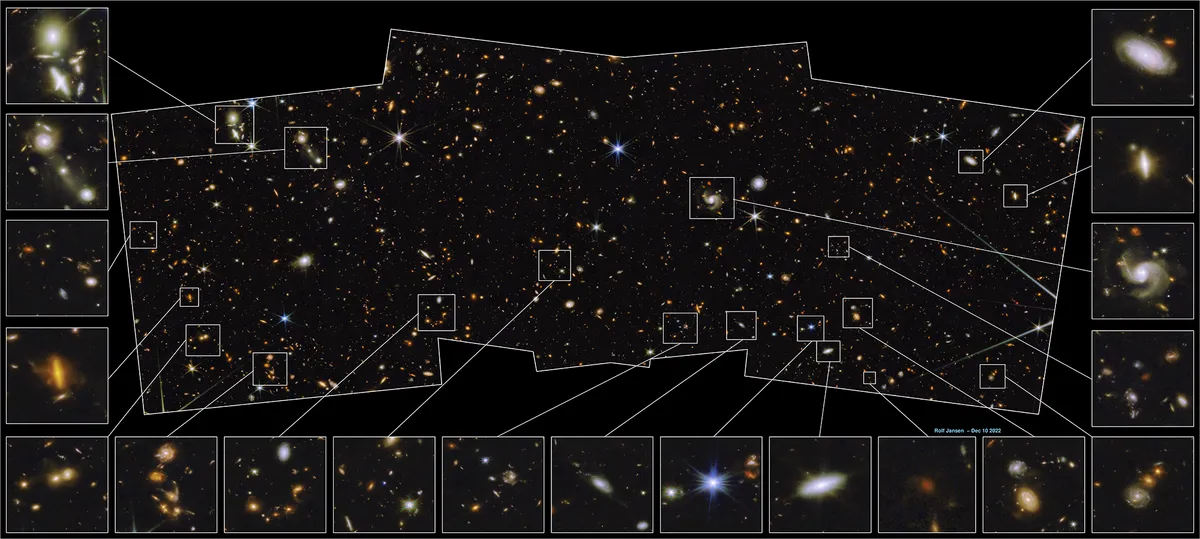
One key part of JWST’s mission will be to use its infrared eyes to peer through the dust and gas to the earliest eras of the Universe.
Here it will help discover how the first stars and galaxies formed, as well as uncover fresh evidence for dark matter.
JWST’s Advanced Deep Extragalactic Survey (JADES) has been allocated a month of JWST’s observing time, spread out over two years, and takes advantage of the telescope’s unprecedented sensitivity to investigate the earliest galaxies in greater detail than ever before.
In December 2022, JWST discovered the most distant, and therefore earliest, galaxies ever found – at least up to that point.
The light from these galaxies set out when our Universe was just two per cent of its current age, and has taken the last 13.4 billion years to reach us.

JADES focused JWST on the same patch of sky as Hubble’s Ultra Deep Field, located in the Fornax Cluster.
While Hubble found an impressive 10,000 galaxies in the region, JWST’s image is 15 times larger, and contains a staggering 100,000 galaxies.
Astronomers are still sifting through this deluge, looking for the most distant galaxies among them.
One ‘easy’ way to pick out distant candidates is to use the fact that hydrogen gas absorbs almost all light at wavelengths shorter than 91nm, called the Lyman limit.
Since galaxies are filled with hydrogen, this creates a sharp ‘step’ in their ultraviolet and X-ray emissions.
However, as light travels through space it is stretched (or redshifted) due to the expansion of the Universe.
The longer it travels, the more it stretches, until this step in emissions moves into the visible range.
Astronomers can use the position of this ‘Lyman break’, to work out how far away a galaxy is.
For 28 hours over three days, JWST collected the faintest infrared spectra ever taken from 250 candidate galaxies, revealing the precise position of the Lyman break in each galaxy.
This confirmed that four of the galaxies had a redshift above 10, setting new distance records, including two with redshifts of 13.
JADES will now study Hubble’s Deep Field, a small region in Ursa Major, before returning to the Ultra Deep Field, so we can expect many more ‘most distant galaxies’ to be confirmed in the future.
The evolution of galaxies
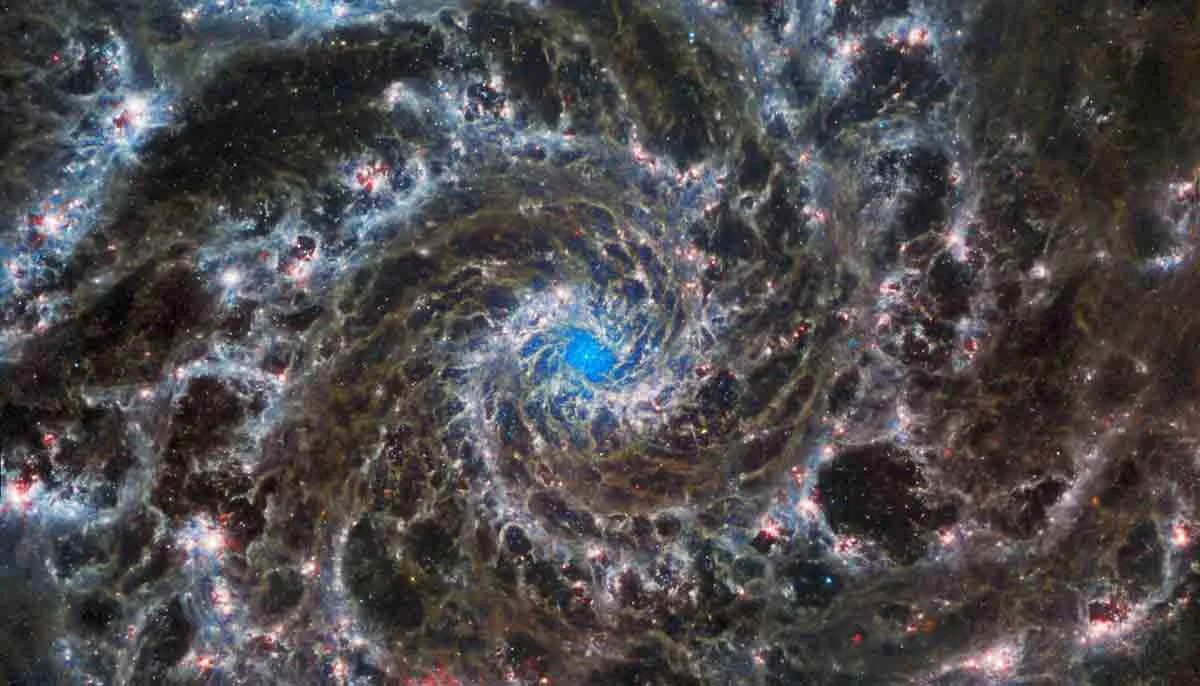
The early Universe was a far busier place than it is today.
Ten billion years ago, the rate at which stars burst into life and galaxies crashed together was 10 times higher.
JWST aims to investigate the driving force behind this activity – as well as its sharp decline – by tracking galaxies over time to see how they have evolved.
JWST is able to study areas previously hidden from view and begin to reveal how the formation of stars – some of the smallest objects in the Universe, cosmologically speaking – can influence the structure and evolution of some galaxies, some of the largest objects in the Universe.
The Physics at High Angular resolution in Nearby Galaxies Survey (PHANGS) represents the largest survey of nearby galaxies in JWST’s first year of science.
Its international team of 100 researchers are investigating 19 diverse spiral galaxies and have already made observations of five of their targets, including the spiral galaxy, NGC 1433.
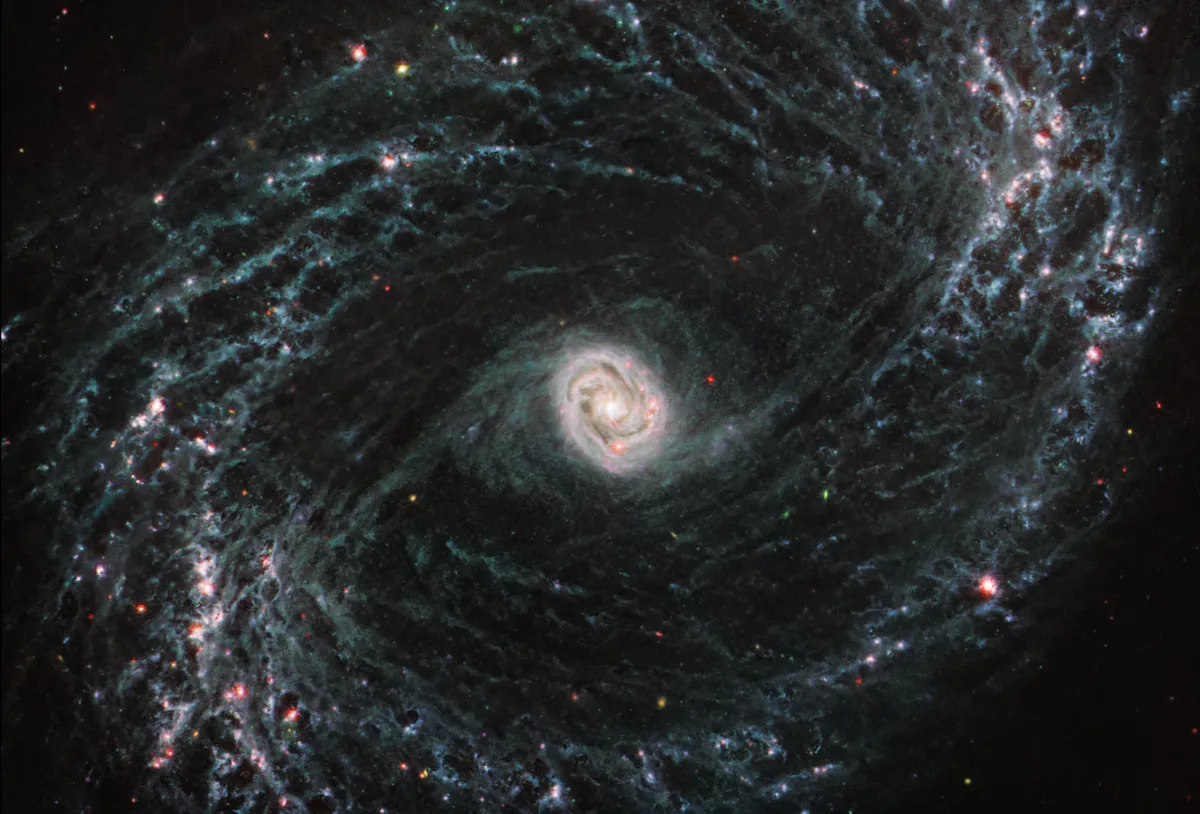
NGC 1433 lies 46 million lightyears from Earth in the Southern Hemisphere constellation of Horologium.
The galaxy has a tight, bright core that features a unique double ring of tightly wrapped spiral arms, wound into an oval structure along its central bar.
JWST’s sensitivity to infrared has revealed a network of cavities and huge bubbles of gas lining the galaxy’s spiral arms, which had previously been hidden by clouds of dust in the galaxy.
The cavities are formed by young stars interacting with the gas surrounding them, and so will help give key insights into how star formation shapes growing galaxies.
PHANGS will continue to survey galaxies with JWST, and combine these observations with data previously taken by other telescopes to conduct a complete census of star formation in nearby galaxies, beyond the Local Group, to reveal how star formation gave rise to, or impeded, the formation of the next generation of stars at earlier stages in the Universe’s evolution.
Stars blowing bubbles
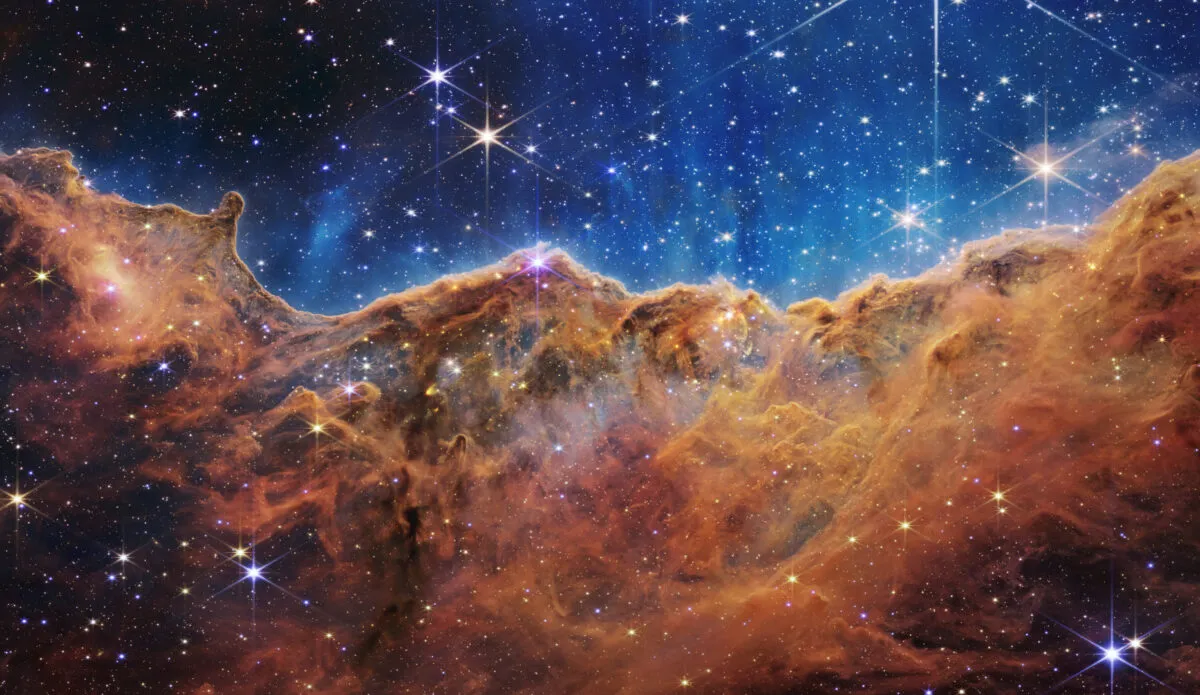
Stars begin their lives in dense clouds of obscuring dust and gas, but JWST’s high-resolution infrared capabilities are able to pierce through this and reveal stars growing in their cosmic nurseries.
One of the first images released by JWST back in July 2022 was of NGC 3372, a young star-forming region 7,600 lightyears away, in the northwest corner of the Carina Nebula, NGC 3372.
JWST’s infrared instruments revealed the edge of a gigantic gaseous cavity – a huge bubble created by the intense radiation and stellar winds from nearby massive, hot, young stars, dubbed the Cosmic Cliffs.
As the ionised rim of the bubble pushes into the gas and dust of the nebula, the change in pressure can cause either a boom or bust – material either collapses to form new stars or erodes away, preventing star formation.
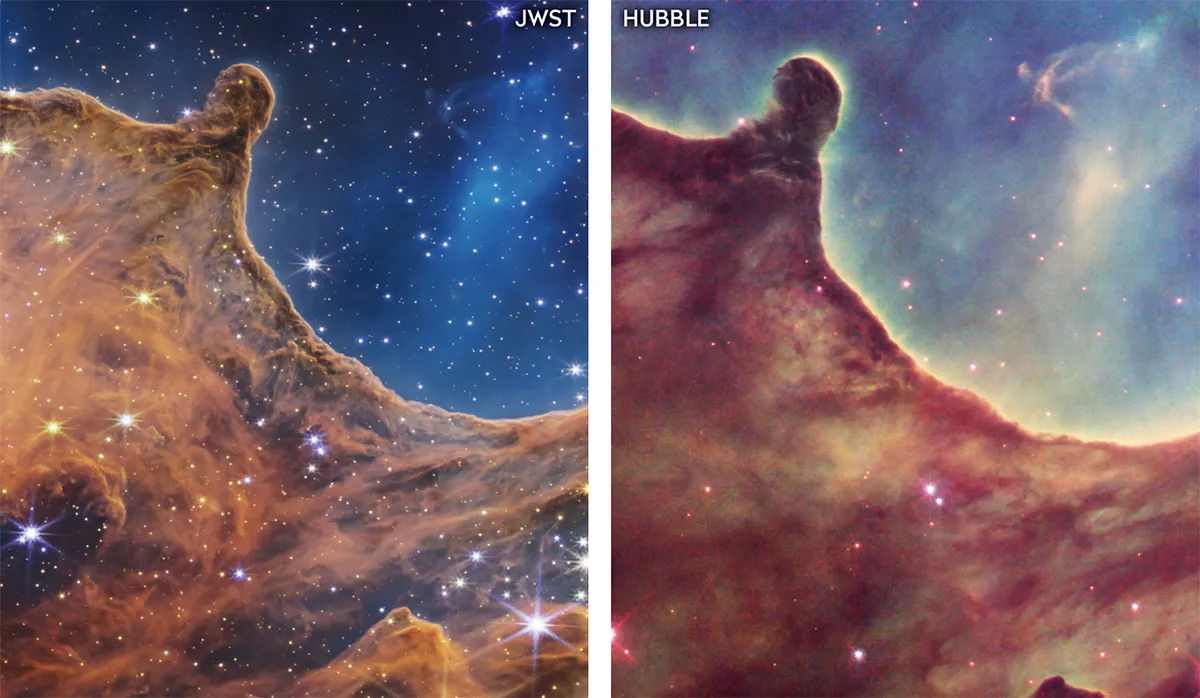
Dense clouds form more massive stars, which in turn drives the gas into voids and denser regions where lower-mass stars form.
As the growing stars pull material in, high-velocity jets of gas and dust stream from the stars’ poles.
These jets only appear briefly, during periods of active accretion, but astronomers have still managed to find 24 such flows.
Instead of a steady stream, these flows are chains of dense, fast-moving clumps, indicating that accretion occurs in a series of short, powerful bursts.
Monitoring these outflows allows astronomers to estimate how fast they move, how much mass they carry and their effect on growing stars and planets.
The chemical profiles of exoplanets

We now know of thousands of planets beyond our Solar System, but while we may know the size, mass and orbit of these worlds, understanding of the atmospheres above them has proved elusive.
Whether a ‘hot Jupiter’ or a small, rocky planet, knowing what is above the world gives key insights into their composition, formation and evolution.
However, JWST’s sensitive instruments can distinguish a far wider range of atmospheric molecules than ever before.
In August 2022, JWST achieved a hat-trick of firsts when it made its first science observation of an exoplanet, where it also obtained the first detailed exoplanet spectrum in near-infrared and the first indisputable evidence for carbon dioxide in an exoplanet’s atmosphere.
The exoplanet in question was WASP-39b, a hot gas giant 700 lightyears away, discovered in 2011.
It is roughly the same mass as Saturn, but with a diameter 1.3 times greater than Jupiter.
It orbits its parent star eight times closer than Mercury orbits the Sun, giving it a surface temperature of 900˚ Celsius.
JWST watched the planet as it passed in front of its star and detected the starlight that filtered through the planet’s atmosphere.
Different molecules in the atmosphere absorbed certain wavelengths of light, leaving ‘fingerprints’ in the star’s spectra that JWST was able to pick up.
Previous observations found isolated molecules of water vapour, sodium and potassium.
JWST’s sensitivity to infrared added sulphur dioxide, carbon monoxide and carbon dioxide to the list.
The latter of these could be an important indicator of a planet’s potential to support life, showcasing JWST’s role in the search for habitable, Earth-like worlds.
A fresh look at Jupiter
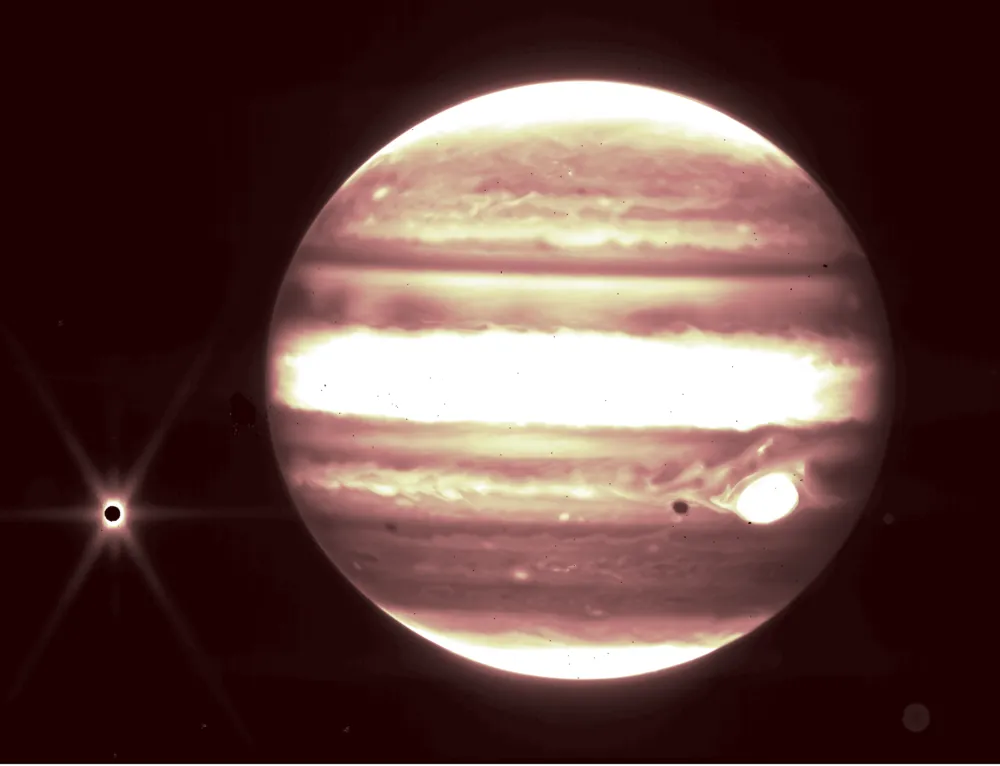
JWST will also take a look a little closer to home at the planets within our own Solar System, and it has already turned its eyes on several of our planetary neighbours.
As planets only shine by reflecting starlight, they do not emit much energy or visible light, yet they still radiate in infrared, making them ripe candidates for JWST.
JWST’s near- and mid-infrared sensitivity can look through the atmosphere to different depths, highlighting the evolution of cloud structures and storms in finer detail than ever before.
Three specialised infrared filters on JWST’s near-infrared camera, NIRCam, turned their sights on Jupiter, the largest planet in our Solar System.
Each filter is assigned a colour – red, yellow/green or blue – to allow astronomers to transpose the invisible infrared into something we can see.
The resulting image is a composite, as Jupiter’s fast rotation (once every 10 hours) makes aligning the separate images a challenge since features move during the time it takes to capture the images.
While the image below shows aurorae high above both of Jupiter’s poles, each filter highlights a different aspect of the planet’s atmosphere.
The red filter highlights the lower clouds and upper hazes.
The yellow/green filter also shows hazes around the poles, while the blue filter shows up the deeper main cloud.
The brightness of features represents their altitude.
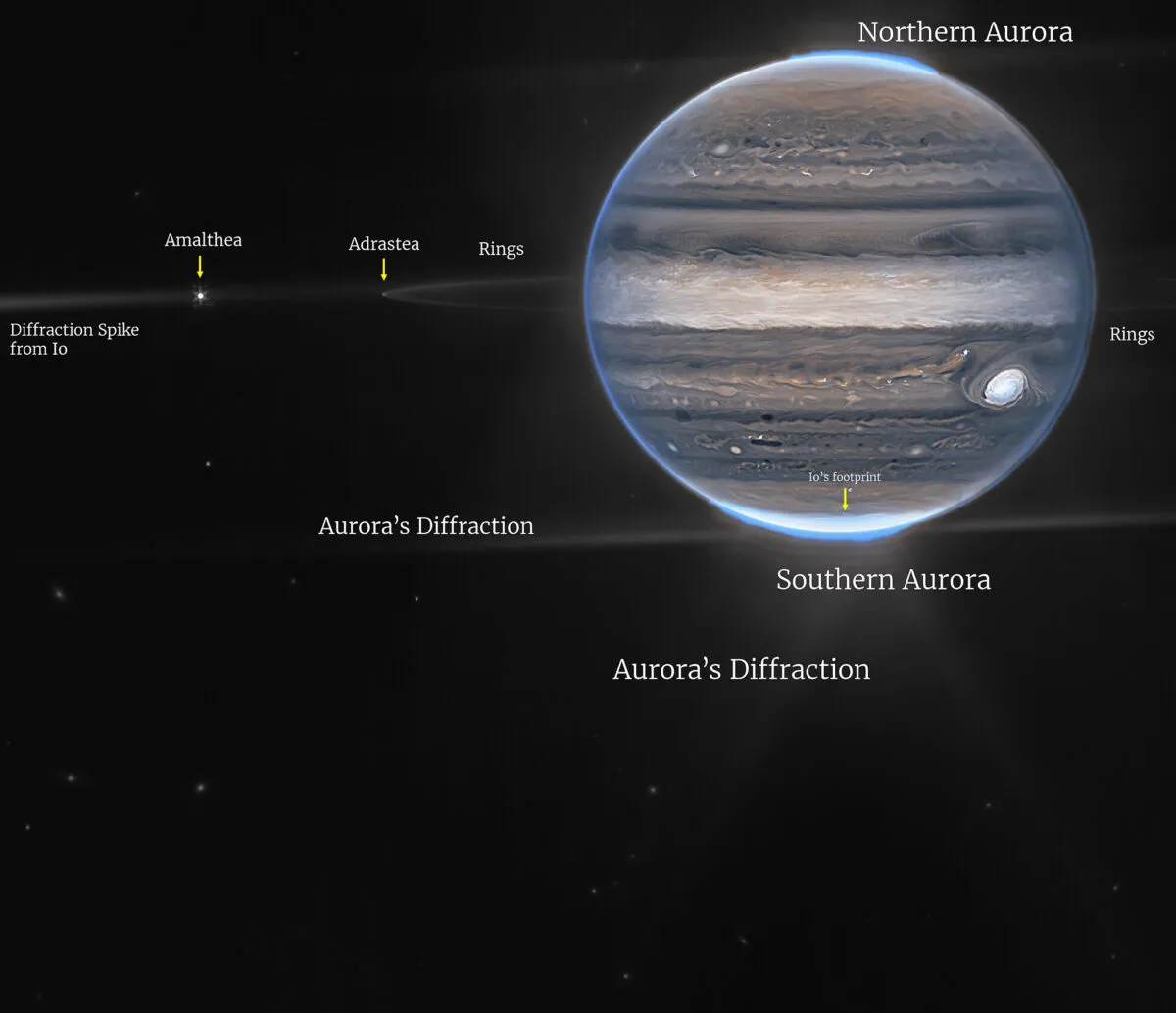
Some clouds, and the famous Great Red Spot, are dazzling white, due to their very high-altitude cloud tops of condensed storms reflecting a lot of sunlight.
The higher-altitude clouds of the bands north of the planet’s equator, meanwhile, appear dark.
It’s not just the planet itself the telescope is looking at.
A widefield view shows Jupiter’s faint ring and two of its tiny moons, Amalthea and Adrastea.
In future, JWST will turn towards Jupiter’s largest moon, Ganymede, to study the potential ocean hidden beneath its surface, and search for previously undetected volcanoes on Io.
This guide originally appeared in the July 2023 issue of BBC Sky at Night Magazine.

